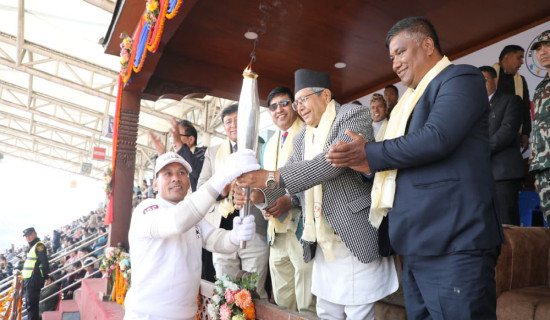- Sunday, 28 December 2025
Policy Dilemma In Agriculture Sector
The transformation of agriculture has been the most discussed issue in Nepal, marked by notable shifts in the dynamics of factors of production, including land, labour, and capital markets. The predominant goals of agricultural policies have consistently centred on modernization, commercialization, and mechanisation, aiming to propel the sector into a more contemporary and efficient state. The government's policy also envisions enhancing productivity, improving crops through breeding, ensuring input availability, and providing market assurance. In the course of modernization, issues such as germplasm maintenance, ecological agriculture, conservation of landraces, high-value crop plantation, and climate-smart agriculture are also gaining importance. Political concern has also increased regarding the growing trend of food imports. The once self-sufficient country in major staple foods is now becoming a net importer.
Due to the scarcity of factors of production, we must acknowledge that being self-sufficient in all products is not feasible. However, we can make proper crop choices to achieve sufficiency in strategic crops. Yet, unanswered questions persist concerning crop selection. What crop should I cultivate on my small parcel of land? Should I cultivate paddy to feed my family, or should I consider vegetables, fruits, or other cash crops? If I choose paddy, should I cultivate local landraces with lower productivity for better quality, or should I go for improved or hybrid paddy to increase production? Should I rely on organic production, or should I pursue inorganic farming? These are serious dilemmas in the mindset of farmers before cultivation. However, the decisions made by farmers at the household level against these dilemmas continuously impact the food production status and agricultural trade potential of the country.
Additionally, what recommendations does the government provide for farmers in specific regions? Is the government promoting crops with trade potential, or is it focusing on major staple food crops for self-sufficiency and subsistence? What has been envisioned by our policies? What could be the best decision for sustainable agricultural development and food security? The middle way between self-sufficiency and trade, and subsequent adjustments based on the extent of influence by advocates, has been the common practice in planning and budgeting for decades. This scenario is responsible for the uncontrolled and unnatural behaviour and shifts in crop choice, production, productivity, land abandonment, and farmers' migration.
The policy dilemma is observed between achieving self-sufficiency in major staple food crops like paddy, maize, etc., or focusing on the production of cash crops and tradable commodities, leveraging advantages from microclimates and agrobiodiversity. There is a need to increase the production and productivity of major staple food crops for self-sufficiency and food security. However, the system requires government subsidies and support in both production and marketing to enhance its competitive capacity in the changing scenario of labour shortages and increased cultivation costs. On the other hand, opting for cash crops and tradable or exportable commodities is more likely to yield premium prices and enhance competitive capacity. Perennial cropping appears to be a strategy employed by farmers to combat labor shortages.
The increasing trend of peri-urban vegetable farming, establishing perennial fruit orchards, and cultivating exportable commodities like tea, coffee, cardamom, etc. can be observed as evidence of this transformation. However, both farmers and government policies seem to be stuck in a puzzle when it comes to making crop choices.
Our agricultural policies appear to be well-documented, covering a comprehensive range of agricultural issues and promoting various commodities and sectors without leaving anyone behind. For instance, our policies outline the promotion of both organic agriculture and chemical fertiliser use, endorsing hybrid varieties as well as indigenous landraces for all crops without specifying the applicable areas. However, we lack a concrete action plan for the classification of areas and budget allocation within the sector, even in the face of contradicting issues. It seems that we are content with providing material subsidies to farmers based on their requests. Consequently, agricultural development programmes seem more like political initiatives aimed at attracting votes than genuine efforts to promote agriculture.
Unfortunately, we find ourselves delayed in addressing contradicting issues, such as promoting maize production and protecting monkeys in the same geographical region. These issues call for urgent action through policy review, with a focus on developing a concrete action plan and allocating fiscal resources proportionately. Recognising that a single idea cannot be universally applicable in our diverse context, it is imperative that we do not delay in deciding our priorities for specific interventions, strategic action plans, and collaborative efforts.
In the emerging trend of migration and non-farm employment opportunities, farmers can no longer sustain themselves at a subsistence level or below. Our farming population is ageing, and successors are not readily available in the rural community due to the limited appeal of agriculture, primarily because of its subsistence nature and various associated risks.
The comparative and competitive advantages have deteriorated over time due to the reduced scale of production resulting from land fragmentation. Nevertheless, the increased availability of inputs and technology and the development of infrastructure such as irrigation and road networks have enhanced opportunities for the sector's development.
For example, at the national level, self-sufficiency in major staple food grains like paddy is an important parameter for food security and is also a matter of nationality and sovereignty. Self-sufficiency in rice is pivotal for measuring the sufficiency of the agriculture sector. In those conditions, we should not be behind in intervening in rice production. Limiting the low-yielding local landraces to protection level only, we must concentrate on the use of hybrids and improved varieties along with research and development.
The rice crop demands a special structure of land with irrigation facilities, so our policy must include an action plan to classify and protect rice land. This is crucial because the threat to rice land often arises more from within the agriculture sector due to shifts in crop choices than from outside the sector. Recognising the criticality and ultimate importance of rice due to food habits, rice producers must be prioritised for fertiliser distribution, mechanisation, seed replacement, automatic insurance services, and support prices.
Thus, considering budget constraints, government intervention must prioritise limited and strategic commodities to show positive results in achieving self-sufficiency and trade benefits. Identifying tradable crops that fetch premium prices and possess competitive capacity is crucial and should be promoted without compromising the areas dedicated to major staple food crop production.
The haphazard crop choices by farmers, as well as the disorganized programming and budgeting by different tiers of government, need to be regulated by the federal ministry. The current federal political structure requires a comprehensive agricultural policy that serves as a guideline for all tiers of government.
Urgent measures are required to halt the trend of public consumption-driven decisions following fashionable emerging commodities and try new approaches every year without a concrete analysis of the impact of policy and programmes for publicity. There is a need for clarity in policies and action plans. Maintaining coherence and consistency in agricultural development policies and fiscal programmes across all tiers of government is essential for striking the right balance between self-sufficiency and trade in agriculture, a key factor in ensuring sustainable agricultural development.
The author is an Agriculture Extension Officer, Gandaki Province.
















